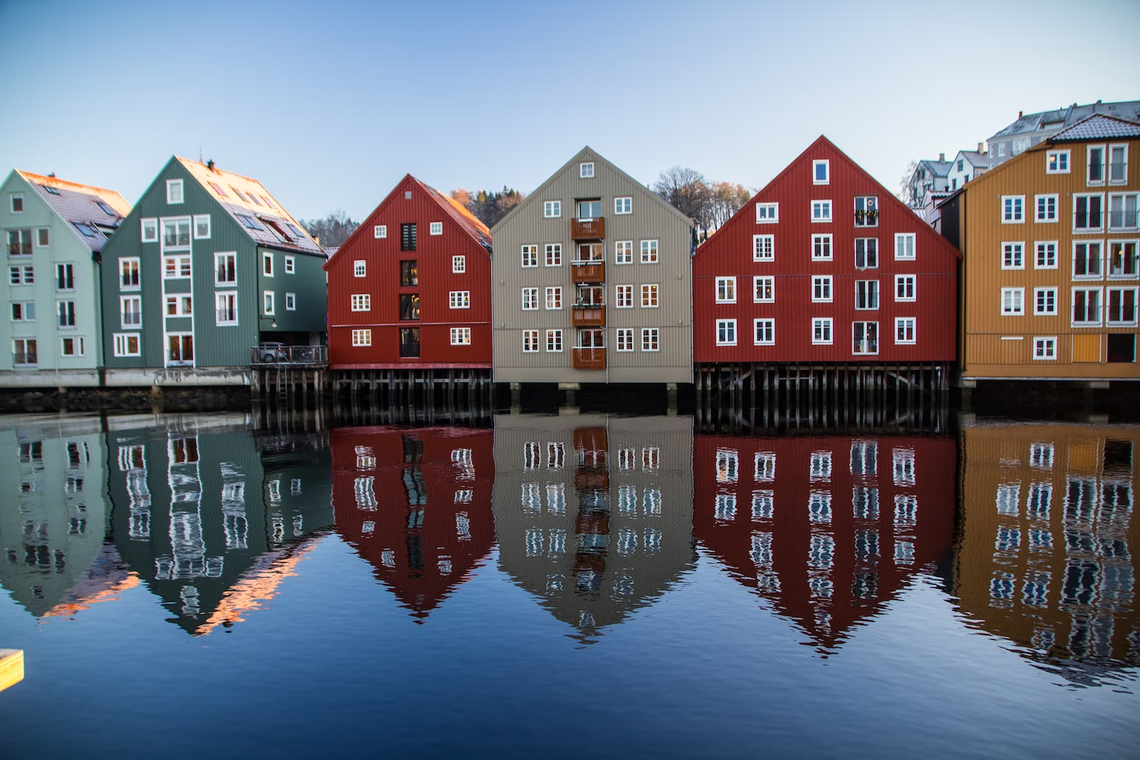Apply to a foreign university with confidence
- Properly fulfilled documents
- Perfect motivation letter
- Support from a personal mentor
- Offers from several universities
Article score: 5 out of 5 (2 reviews)
How to get admitted to a Norwegian university and how hard it is for an international student to do so?
Free consultation




Universities in Norway have always been renowned for their openness, absence of tuition fees, and innovative approach to learning. Despite the modest choice of bachelor's programs in English and the complexity of the local language, Norwegian universities offer an excellent selection of English-language master's and doctoral programs in the most popular and relevant disciplines. All this attracts foreign students aiming at serious mastering of their specialty at universities of one of the most developed and comfortable countries in the world.
Items 1-6 of 80
Advanced search| Type of study | Age | Duration | Min. cost / year | Max. cost / year | Min. language proficiency | English exam | Norwegian exam |
|---|---|---|---|---|---|---|---|
| Foundation | 17+ | 1 year | 7,855 USD | 7,855 USD | B1 | IELTS 5.0-5.5 | Bergenstest |
| Bachelor's | 18+ | 3 years | 7,526 USD | 11,288 USD | B1-B2 | IELTS 5.0-6.5 | Bergenstest |
| Master's | 20+ | 2 years | 4,534 USD | 16,932 USD | B2-C1 | IELTS 6.0-7.5 | Bergenstest |
| MBA | 20+ | 1-2 years | 4,327 USD | 1,881 USD | C1 | IELTS 6.5-7.5 | Bergenstest |
| Doctoral | 20+ | 3 years | 103 USD | 4,233 USD | C1 | IELTS 6.5-7.5 | Bergenstest |
Norway has been participating in the Bologna process since 2003, so the cycles of education in universities are similar to European and includes three stages: bachelor's, master's and doctoral studies.
The academic year is divided into 2 semesters. It starts in August, so foreign students submit documents to state universities strictly before December 1, and in some private universities, documents are accepted until early May.
For admission to English-language programs, you can take both IELTS Academic and TOEFL ibt, and for programs in Norwegian, only the Bergenstest is suitable, which does not differ in levels but confirms the sufficient language proficiency to study in the country.
Requirements in different universities vary, but the standard package of documents includes:
Check the full list of documents and the requirements for paperwork on the universities’ website.
Norwegian universities have a six-point grading scale ranging from "A" (highest) to “F” (lowest), with an “E” being a minimum passing grade. At the end of the semester, exams are held, some of which are graded on a pass / fail basis. Exams are both oral and written, the format largely depends on the teacher.
| Norwegian grades | American GPA | ECTS Scale |
| A | 3.86-4.00 (A) | 90-100 |
| B | 3.12-3.86 (B+) | 80-89 |
| C | 2.37-3.12 (B) | 70-79 |
| D | 1.74-2.37 (C+) | 60-69 |
| E | 1.12-1.73 (C) | 50-59 |
| F | 0.00-1.11 (F) | 0-49 |
Schools also use a six-point system, but instead of letters, numbers are traditionally used: 6 is the maximum score, and 2 is a minimum passing score.
After the education reform of 1994, all Norwegian higher education institutions have been divided into three types: universities, specialized universities, and university colleges.
| Field of study | Number of students[6] |
|---|---|
| Health, welfare and sport | 60141 |
| Business and administration | 55210 |
| Natural sciences, vocational and technical subjects | 51850 |
| Education | 48357 |
| Social sciences and law | 39312 |
| Humanities and arts | 30259 |
| Transport and communications, safety and security and other services | 6991 |
| Primary industries | 1605 |
| Unspecified | 6991 |
| General preparatory programs and colleges | 371 |
University colleges in Norway are equated in status with higher education institutions and include both vocational school elements and university functions. Colleges offer two-year diploma programs in Norwegian, after which you can transfer to university and continue your studies from the third year. Also, colleges have a wide range of bachelor's and master's programs in applied sciences and arts (education, IT, nursing, accounting, logistics, acting, journalism, etc.).
Bachelor’s studies at university colleges in Norway are predominantly taught in Norwegian but up to 20 master's programs in English can be found. English-speaking students should pay special attention to the colleges Østfold, Moldé, NLA, Western Norway University of Applied Sciences, and Inland Norway University of Applied Sciences.
The Military and Police Colleges are distinguished in a separate category, because they are not under the jurisdiction of the Norwegian Ministry of Education. They are taught in Norwegian, and the enrollment of foreign students is limited.
Even in private universities in Norway, you can study almost free of charge, because a number of programs in them are funded by the state (see for example Master's programs in NLA or VID). There are specialized private universities: two theological universities and the Norwegian School of Management (one of the largest universities in Norway — more than 19 thousand students). There are also 6 private university colleges in Norway. If the program is not funded by the state, then the cost of training can reach 23,517 USD per year, depending on the type of program.
Specialized state universities are in great demand among applicants and it is difficult to enter them not only for a foreigner, but also for a local student. Competition in such institutions as the Norwegian School of Economics, Norwegian School of Sport Sciences, and the School of Architecture and Design in Oslo, is from 4.5 to 9.5 applicants per place.
In general, private education is poorly distributed in Norway due to the high quality and availability of public universities and the small population of the county. Not a single private university in Norway has yet been awarded the rank of a research university.
| University | City | University status since | Competition people / place[7] |
|---|---|---|---|
| Norwegian University of Life Sciences | Ås | 2005 | 3.32 |
| OsloMet — Oslo Metropolitan University | Oslo, Akershus | 2018 | 3.17 |
| University of Oslo | Oslo | 1811 | 2.97 |
| University of Stavanger | Stavanger | 2005 | 2.56 |
| University of Agder | Kristiansand, Grimstad | 2007 | 2.45 |
| Norwegian University of Science and Technology | Trondheim, Gjøvik, Ålesund | 1968 | 2.43 |
| University of Bergen | Bergen | 1948 | 2.34 |
| Nord University | Bodø | 2016 | 1.68 |
| University of Tromsø | Tromsø | 1972 | 1.62 |
| University of South-Eastern Norway | Different cities | 2018 | n/a |
All state accredited universities are merged into the Norwegian Association of Higher Education Institutions (UHR) — a total of 33 universities[8]. The organization was created in 2000 to coordinate and interact with accredited public universities, and since 2018 all accredited private institutions have been added to it. Only UHR member universities can issue invitations for international students.
There are no semi-formal associations similar to the Ivy League or Russel Group in Norway, however, among the state educational institutions, the universities like Oslo, Bergen, and Tromso stand out, as they had university status long before the 2005 reform. Also, the Norwegian University of Natural and Technical Sciences, which has a rich history of formation and development since 1760, has a remarkable status.
For a student who is interested in inter-university exchange programs and research scholarships, it is important to pay attention to international associations. For example, the University of Stavanger is a member of the European Consortium of Innovative Universities (ECIU), and the University of Bergen is part of the European Alliance Arqus focused on promoting European values, multiculturalism and social responsibility. In addition, three Norwegian universities are members of the International Association of Universities under UNESCO (Norwegian University of Life Sciences, Universities of Oslo and Bergen).
Previously, studying at public universities in Norway was free for everyone, including foreign students. You only had to pay social fees from 56 USD to 94 USD per year.
But from March 2023, the Norwegian government introduced tuition fees for foreigners[2]. Doctoral studies remain free for everyone. Exchange students and refugees are also exempt from tuition fees.
60+ countries
we work with
$1,000,000 saved
by students through scholarships
6,400 offers
our students got